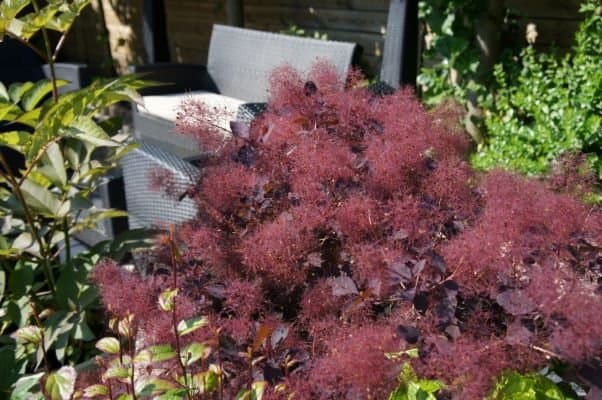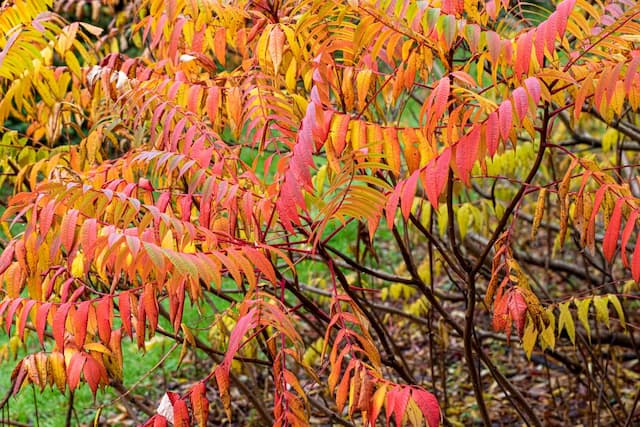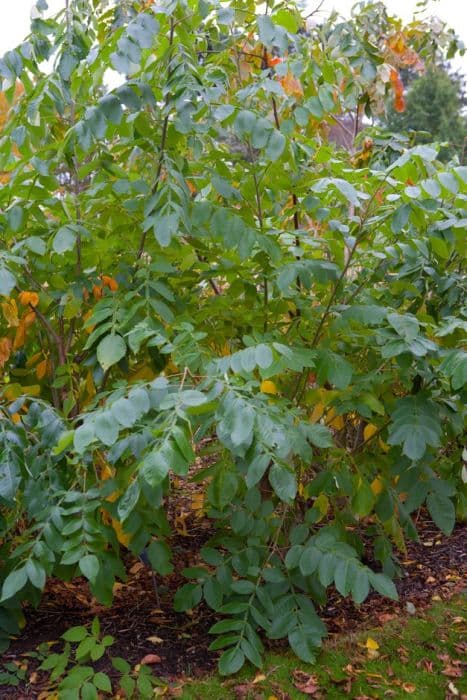Smoke bush Cotinus coggygria 'Young Lady' (PBR)











ABOUT
Cotinus coggygria 'Young Lady', commonly known as the smoke bush 'Young Lady', is a deciduous shrub that is well-regarded for its distinctive fluffy flower plumes which contribute to its common name, evoking the visual effect of smoke. The foliage of 'Young Lady' is a vibrant green during the growing season, which transitions to a mix of stunning oranges and purples in the fall, making it a standout for its autumnal color display. The plant produces panicles of small, feathery flowers in the summer, which have a smoky pinkish hue. These cloud-like blooms make a dramatic display and can cover the bush, offering a decorative appeal that often attracts gardeners and landscapers. The dense flowers give a soft, hazy effect, providing interest and elegance to outdoor spaces. The branches are rounded and the leaves are simple and oval-shaped with pointed ends. The bark on the smoke bush 'Young Lady' is smooth, and the stems may take on a slightly woody texture as it matures. The combination of its colorful foliage and ethereal flowering makes the smoke bush 'Young Lady' a favorite for creating visual interest in the garden without relying on large stature. Overall, the smoke bush 'Young Lady' boasts a graceful appearance that can enhance garden designs with its season-long color and captivating bloom effect that mimics puffs of smoke wafting above the foliage.
About this plant
 Names
NamesFamily
Anacardiaceae.
Synonyms
Smoke Bush, Young Lady Smoke Tree, Venetian Sumach, Young Lady Smoketree.
Common names
Cotinus coggygria 'Young Lady' (PBR).
 Toxicity
ToxicityTo humans
Smoke tree is not commonly known to be toxic to humans. However, as with many plants, individual allergies or sensitivities could potentially cause mild irritation or an allergic reaction when in contact with the skin or if parts of the plant are ingested. There is no well-documented case of Smoke tree causing severe poisoning or symptoms in humans from ingestion, but it is always advisable to avoid eating parts of ornamental plants due to potential unknown toxins or the possibility of individual adverse reactions.
To pets
Smoke tree is not commonly known to be toxic to pets either. As in humans, individual pets may have sensitivities that could lead to mild gastrointestinal upset or an allergic reaction if they come into contact with or ingest parts of the plant. While it does not appear on lists of plants that are highly toxic to pets, caution should be used to prevent pets from ingesting ornamental plants, as they are not intended for consumption and can potentially cause digestive or health issues due to a pet's individual reaction or physical condition.
 Characteristics
CharacteristicsLife cycle
Perennials
Foliage type
Deciduous
Color of leaves
Varies
Flower color
Pink
Height
5 feet (1.5 meters)
Spread
5 feet (1.5 meters)
Plant type
Shrub
Hardiness zones
5
Native area
Europe
Benefits
 General Benefits
General Benefits- Decorative Foliage: The plant features attractive, round foliage that changes color through the seasons, from green to stunning autumnal hues.
- Fluffy Smoke-Like Blooms: Produces unique, feathery flowers in summer, which resemble puffs of smoke and add visual interest to the landscape.
- Drought Tolerance: Once established, it is quite tolerant of dry conditions, requiring minimal watering.
- Low Maintenance: Cotinus coggygria 'Young Lady' is known for being easy to care for and doesn't demand frequent pruning or special treatments.
- Wildlife Attraction: The blooms attract beneficial insects, which aids in pollination and can help maintain a healthy garden ecosystem.
- Compact Size: As a relatively small cultivar, it is suitable for smaller gardens where space is limited.
- Seasonal Interest: Provides year-round interest with its changing foliage, flowers in summer, and ornamental seed heads in autumn and winter.
- Easy Propagation: Can be easily propagated from cuttings, allowing gardeners to create more plants for other areas of the garden or to share with others.
- Versatile Planting Options: Works well in mixed borders, as a specimen plant, or even in large containers, offering flexibility in garden design.
 Medical Properties
Medical PropertiesThis plant is not used for medical purposes.
 Air-purifying Qualities
Air-purifying QualitiesThis plant is not specifically known for air purifying qualities.
 Other Uses
Other Uses- Smoke Bush's dried flowers can be used in potpourri mixes for adding a natural and unique texture to the blend.
- The dense foliage of Smoke Bush can provide a natural privacy screen in gardens and outdoor living spaces.
- Due to its striking foliage and flowers, the Smoke Bush can be used as a living sculpture or focal point in contemporary garden design.
- The wood of the Smoke Bush can be used in small woodworking projects for its interesting grain and color.
- Photographers may use the Smoke Bush as a backdrop in portraits and macro photography due to its unique and ethereal flower clusters.
- Its colorful leaves can be collected in the fall and used for crafts, such as making leaf prints or adding to homemade wreaths.
- Smoke Bush can be incorporated into a sensory garden for its soft, smoke-like flower texture and vibrant foliage.
- During winter, the distinctive seed heads and bare branches of Smoke Bush can be used in decorative outdoor arrangements and festive decor.
- As it resists deer and other herbivores, Smoke Bush is ideal for gardens in areas with wildlife.
- In permaculture, the Smoke Bush can be used as part of a guild to support biodiversity and attract beneficial insects.
Interesting Facts
 Feng Shui
Feng ShuiThe plant Smoke Bush is not used in Feng Shui practice.
 Plant Symbolism
Plant Symbolism- Transformation: The Cotinus coggygria, commonly known as the Smoke Bush or Smoke Tree, undergoes remarkable color changes through the seasons, symbolizing change and transformation.
- Spirituality: The 'smoke' of the Smoke Bush, created by the billowy hairs on the spent flower clusters, is thought to symbolize spiritual ascent or a connection to the ethereal plane.
- Mystery: The Smoke Bush's distinctive, misty 'smoke' can also represent mystery and enigma, echoing the plant's elusive, smoke-like visual effect.
- Illusion: With its smoky appearance, the Smoke Bush can symbolize illusion or the act of obscuring the true form of something, suggesting things are not always as they appear.
- Beauty in Aging: As the Smoke Bush matures through the seasons and its leaves turn brilliant colors, it symbolizes the beauty and grace that comes with age and the passing of time.
 Water
WaterSmoke bush 'Young Lady' prefers to be watered when the top inch of soil feels dry to the touch. It typically requires watering every 5 to 7 days during the growing season, but this can vary depending on temperature and humidity. Use a watering can to evenly moisten the soil without over-saturating it, ensuring it receives thorough watering each time which might be around 1 to 1.5 gallons for a mature plant. During the winter, reduce watering frequency to every 2 to 3 weeks as the plant's water needs decrease. Adjust watering based on weather conditions and always allow the soil to dry out slightly between waterings.
 Light
LightSmoke bush 'Young Lady' thrives in full sun to partial shade. It is best positioned in a spot where it can receive at least 6 hours of direct sunlight each day, which encourages optimal foliage color and bloom production. However, in extremely hot climates, some afternoon shade can help protect the plant from scorching.
 Temperature
TemperatureSmoke bush 'Young Lady' can withstand a range of temperatures and is hardy in USDA zones 5 through 8. It can survive temperatures as low as -20 to -10 degrees Fahrenheit and as high as 90 to 100 degrees Fahrenheit, but it prefers a moderate climate. The ideal temperature range for this plant is between 60 and 80 degrees Fahrenheit.
 Pruning
PruningPruning the smoke bush 'Young Lady' is essential to maintain its shape and to promote the growth of the smoke-like puffs for which it is named. Prune in late winter or early spring before new leaves emerge. Remove any dead or damaged branches and trim back up to one-third of the plant to encourage new growth. It can be pruned annually; however, heavy pruning should be done every few years to rejuvenate older plants.
 Cleaning
CleaningAs needed
 Soil
SoilSmoke bush thrives in well-draining soil enriched with organic matter; a mix of loam, peat, and sand is ideal. It prefers a soil pH ranging from mildly acidic to neutral, roughly between pH 5.5-7.5.
 Repotting
RepottingSmoke bush, being a large shrub, is not commonly repotted and is often planted directly into the garden. Young plants may be repotted every few years until they are established in the landscape.
 Humidity & Misting
Humidity & MistingSmoke bush prefers average outdoor humidity levels and does not require specific humidity conditions; it is quite adaptable to different atmospheric moisture levels.
 Suitable locations
Suitable locationsIndoor
Smoke bush rarely grows indoors, needs ample light.
Outdoor
Plant smoke bush in full sun, well-draining soil.
Hardiness zone
5-9 USDA
 Life cycle
Life cycleCotinus coggygria 'Young Lady', commonly known as Smoke Bush, begins its life cycle when the seeds germinate in favorable conditions of warmth and moisture. After germination, the seedling develops a root system and foliage, entering the vegetative growth stage, where it focuses on leaf and stem development. As the plant matures, it enters the flowering stage, typically in late spring to early summer, producing feathery, smoke-like inflorescences that are highly ornamental. After pollination, the flowers develop into small, spherical fruits, each containing a seed that will disperse to begin a new life cycle. In late autumn, Smoke Bush prepares for dormancy, shedding its leaves in response to cooler temperatures and shorter days. During its dormant period in winter, the plant stores energy in its roots, ready to resume growth in the following spring.
 Propogation
PropogationPropogation time
Spring-Early Summer
The Cotinus coggygria 'Young Lady', commonly known as Smoke Bush, is most commonly propagated through softwood cuttings. This method typically takes place in late spring or early summer when the new growth is still green and flexible. Cuttings should be about 4 to 6 inches (10 to 15 centimeters) long and include several leaves. The lower leaves are removed, and the cut end is dipped in rooting hormone to encourage root development. The cutting is then placed in a well-draining potting mix and kept moist until roots have developed, which usually takes several weeks. It is important to keep the cuttings in a warm area with indirect sunlight during this rooting phase.




